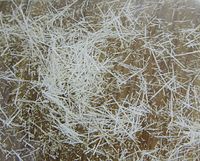
| |

| |

| |
| Names | |
|---|---|
| IUPAC name
Diazidolead
| |
| Identifiers | |
3D model (JSmol)
|
|
| ChemSpider | |
| ECHA InfoCard | 100.033.206 |
| EC Number |
|
PubChem CID
|
|
| UNII | |
| UN number | 0129 |
CompTox Dashboard (EPA)
|
|
| |
| |
| Properties | |
| Pb(N3)2 | |
| Molar mass | 291.2 g·mol−1 |
| Appearance | White powder |
| Density | 4.71 g/cm3 |
| Melting point | 190 °C (374 °F; 463 K) decomposes,[2] explodes at 350 °C[1] |
| 2.3 g/100 mL (18 °C) 9.0 g/100 mL (70 °C)[1] | |
| Solubility | Very soluble in acetic acid Insoluble in ammonia solution,[1] NH4OH[2] |
| Thermochemistry | |
Std enthalpy of
formation (ΔfH⦵298) |
462.3 kJ/mol[1] |
| Explosive data | |
| Shock sensitivity | High |
| Friction sensitivity | High |
| Detonation velocity | 5180 m/s |
| Hazards | |
| Occupational safety and health (OHS/OSH): | |
Main hazards
|
Harmful, explosive |
| GHS labelling: | |
    [3] [3]
| |
| Danger | |
| H200, H302, H332, H360, H373, H410[3] | |
| NFPA 704 (fire diamond) | |
| 350 °C (662 °F; 623 K) | |
| Related compounds | |
Other cations
|
Potassium azide Sodium azide Copper(II) azide |
Related compounds
|
Hydrazoic acid |
Except where otherwise noted, data are given for materials in their standard state (at 25 °C [77 °F], 100 kPa).
| |
Lead(II) azide Pb(N3)2 is an inorganic compound. More so than other azides, it is explosive. It is used in detonators to initiate secondary explosives.[5] In a commercially usable form, it is a white to buff powder.
- ^ a b c d Pradyot, Patnaik (2003). Handbook of Inorganic Chemicals. The McGraw-Hill Companies, Inc. ISBN 0-07-049439-8.
- ^ a b CID 61600 from PubChem
- ^ a b "Safety Data Sheet of Electronic Detonators, Division 1.4" (PDF). ocsresponds.com. Owen Oil Tools LP. 2014-03-21. Retrieved 2014-06-09.
- ^ Keller, J.J. (1978). Hazardous Materials Guide: Suppl, Issue 4. Abel Guerrero.
- ^ Greenwood, Norman N.; Earnshaw, Alan (1997). Chemistry of the Elements (2nd ed.). Butterworth-Heinemann. p. 433. ISBN 978-0-08-037941-8.
